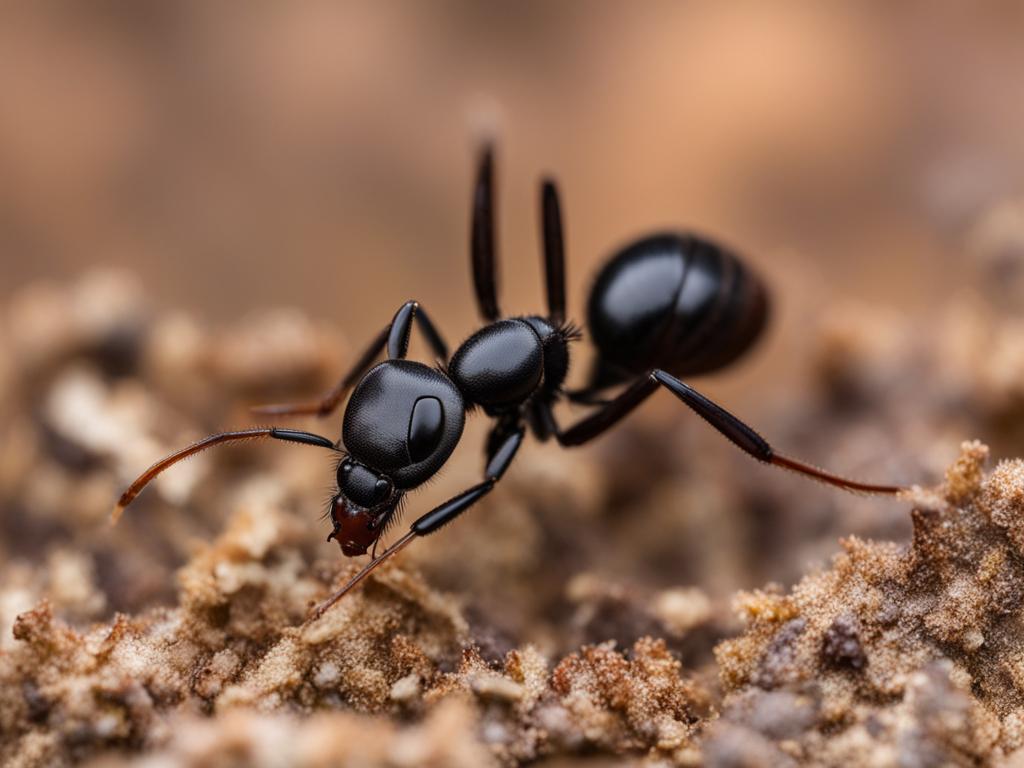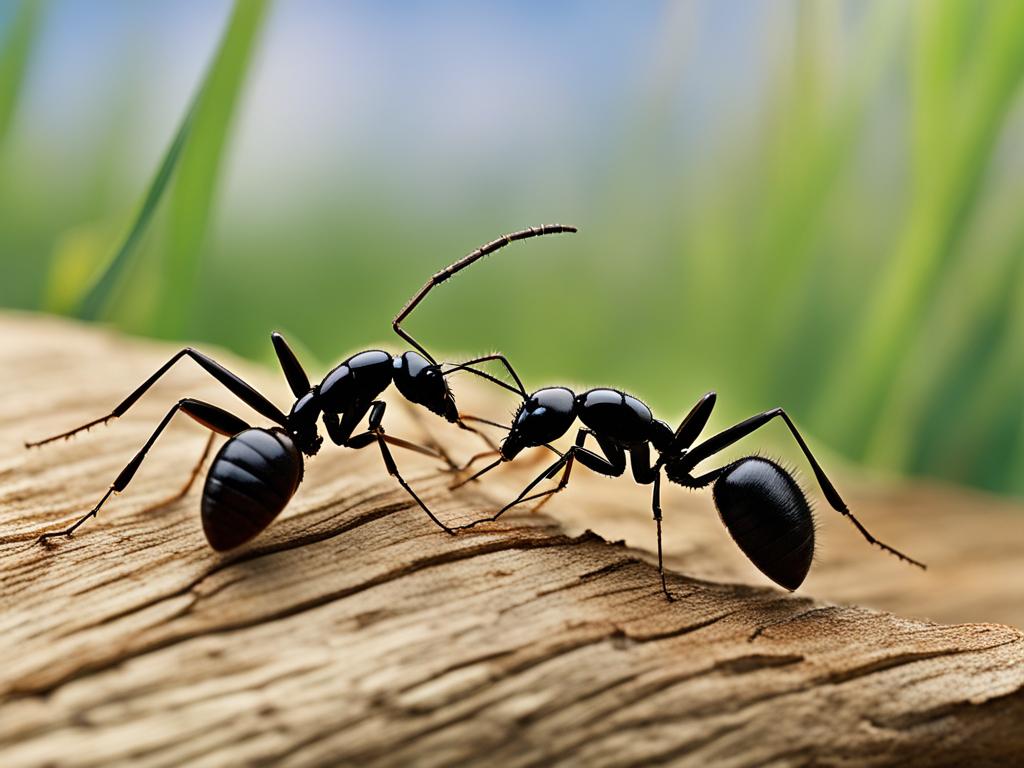Field ants and carpenter ants may look similar at first glance, but they are two distinct species with notable differences. To accurately identify these ants and understand their behavior, it is crucial to recognize the key differentiating factors between them.
When comparing field ants and carpenter ants, one of the primary distinguishing features is their thorax. Field ants have two distinct curves, giving their thorax a unique appearance when viewed from the side. On the other hand, the thorax of carpenter ants has a continuous silhouette without any curves.
In terms of size, field ants are medium-to-large in size for an ant, with a single waist segment. Both field ants and carpenter ants belong to the subfamily of Formica and Camponotus, respectively.
By understanding the differences between field ants and carpenter ants, you can better address any issues related to these pests. Let’s explore their habitat, physical attributes, behavior, and more to gain a comprehensive understanding of each species.
Key Takeaways:
- Field ants and carpenter ants can be distinguished by looking at the shape of their thorax. Field ants have two distinct curves, while carpenter ants have a continuous silhouette.
- Field ants are medium-to-large in size, while carpenter ants have a range of sizes, including larger species.
- Both field ants and carpenter ants belong to different subfamilies: Formica and Camponotus, respectively.
- Understanding the differences between these two ant species is essential for effective pest control and management.
- Further sections will explore their habitat, physical attributes, behavior, and tips for prevention and control.
Habitat and Nesting Behavior
In order to understand the behavior and habits of field ants and carpenter ants, it is important to examine their respective habitats and nesting preferences. By doing so, we can gain valuable insights into their unique characteristics and behaviors.
Field Ant Habitat:
Field ants are primarily soil nesters, preferring to create mounds in fields, lawns, and at the tip of the grass. These ants can also be found under rocks and landscape timbers, utilizing the surrounding environment to establish their colonies.
Carpenter Ant Nesting Habits:
In contrast, carpenter ants have a preference for burrowing and nesting inside structures. They seek out areas such as porches, windowsills, and roofs to establish their nests. Carpenter ants are particularly attracted to moist wood and are commonly found in dead trees. Additionally, they have the ability to establish satellite colonies in cracks and crevices of sound wood, further solidifying their presence.
Understanding the unique habitats and nesting habits of field ants and carpenter ants allows us to develop effective strategies for identification, prevention, and control. By recognizing these distinct behaviors and preferences, homeowners and pest control professionals can take targeted actions to manage and mitigate ant infestations.
Physical Attributes
Field ants and carpenter ants share many physical attributes that make them similar in appearance. Both ants can vary in color, ranging from black, brown, yellow, to red. Their bodies have an unevenly rounded thorax, which helps to distinguish them from other ant species. However, there are key differences that can aid in identifying these ants.
When examining the thorax, field ants have two distinct curves, giving their bodies a unique shape. On the other hand, carpenter ants have a single curve in their thorax. This feature is an important characteristic that sets them apart.
Additionally, field ants possess three tiny white dots known as ocelli, which are located on the front of their head between their compound eyes. This is another feature that can aid in identifying them from other ant species.
To summarize:
- Field ants and carpenter ants have similar physical attributes
- Both ants can range in color from black, brown, yellow, to red
- The thorax of field ants has two distinct curves, while carpenter ants have a single curve
- Field ants have three ocelli on the front of their head
Here is a visual representation of the physical attributes of field ants and carpenter ants:
| Physical Attributes | Field Ants | Carpenter Ants |
|---|---|---|
| Color | Black, brown, yellow, red | Black, brown, yellow, red |
| Thorax Shape | Two distinct curves | Single curve |
| Ocelli | Present | Absent |
By understanding the physical attributes of field ants and carpenter ants, you can effectively identify these ants and make informed pest control decisions.

Behavior and Diet
Field ants exhibit fascinating behavior patterns and have unique dietary preferences that set them apart from carpenter ants.
Field Ants: Behavior
Field ants are known for their remarkable ability to create intricate underground tunnel systems in their nest sites. These tunnel systems provide shelter, protection, and efficient transportation between different chambers within the colony. The field ants work together in an organized manner to construct and maintain these complex networks.
Field ants are also highly social insects, living in colonies that can range in size from a few hundred to thousands of individuals. Within the colony, different individuals have specific roles and responsibilities, ensuring the smooth functioning of the community.
Field Ants: Diet
The diet of field ants primarily revolves around the consumption of honeydew. Honeydew is a sweet, sticky substance produced by aphids and other plant-sucking insects. Field ants have a mutualistic relationship with these insects, as they “farm” them for their honeydew.
Field ants carefully tend to aphids and protect them from predators in exchange for their sugary secretions. They stroke the aphids’ abdomens with their antennae, stimulating the production of honeydew. The field ants then collect and consume this honeydew as a vital source of nutrition.
Carpenter Ants: Behavior
Unlike field ants, carpenter ants have nocturnal behavior. They are most active during the night and prefer to hollow out their nests in softened wood. These ants use their powerful jaws to excavate galleries and create elaborate tunnel systems inside structures such as porches, windowsills, and roofs.
Carpenter ants are highly efficient at navigating through wood, leaving behind smooth tunnels and chambers. The complexity of their nest structures allows them to establish satellite colonies in cracks and crevices of sound wood, further expanding their territory.
Carpenter Ants: Diet
The diet of carpenter ants consists of a combination of protein-based foods and sweet-based foods. They are opportunistic predators and scavengers, feeding on both living and dead insects. Carpenter ants play a vital role in controlling the population of other arthropods in their habitat.
In addition to protein-based foods, carpenter ants also have a sweet tooth. They consume substances rich in sugars, such as honeydew, nectar, and syrups. These sweet-based foods provide a secondary source of energy for carpenter ants.
| Field Ants | Carpenter Ants |
|---|---|
| Build intricate underground tunnel systems | Hollow out nests in softened wood |
| Feed on honeydew produced by aphids | Consume protein-based foods like insects |
Invasion and Prevention
Field ants can be quite persistent when it comes to finding their way into our homes. They have a knack for infiltrating through small cracks and openings, such as damaged window and door seals. To prevent an invasion of field ants, homeowners should take proactive measures to secure their living spaces.
Here are some effective tips to prevent field ant invasion:
- Inspect and repair foundation: Regularly check for any cracks or gaps in the foundation of your house and promptly repair them. Field ants can exploit even the tiniest openings to gain entry.
- Seal windows and doors: Ensure that all windows and doors are properly sealed to eliminate potential entry points. Seal gaps and cracks around the frames using caulk or weatherstripping.
- Fix damaged screens: Check screens on windows and doors for tears or holes. Repair or replace them as necessary to prevent ants from sneaking in.
- Keep the surroundings clean: Field ants are attracted to debris, fallen leaves, and organic matter. Keep your yard tidy by regularly cleaning debris and trimming back shrubs and trees. This reduces potential nesting sites and makes your property less inviting to ants.
- Proper food storage: Store food in airtight containers to prevent attracting field ants into your home. Make sure to seal any food packages or containers tightly to avoid any potential ant infestations.
By following these preventive measures, you can significantly reduce the likelihood of field ant invasions in your home and ensure a pest-free living environment.

| Prevention Tips | Description |
|---|---|
| Inspect and repair foundation | Regularly check for cracks or gaps in the foundation of your house. Repair any openings promptly. |
| Seal windows and doors | Ensure all windows and doors are properly sealed using caulk or weatherstripping. |
| Fix damaged screens | Check screens on windows and doors for tears or holes. Repair or replace as necessary. |
| Keep the surroundings clean | Regularly clean debris, fallen leaves, and trim shrubs and trees to reduce potential nesting sites. |
| Proper food storage | Store food in airtight containers and seal all packages tightly. |
Comparison with Carpenter Ants
When it comes to field ants and carpenter ants, there are several key differences in their behavior and nesting habits.
Nesting Habits
Field ants are known for their preference for living in underground tunnel systems within the soil. These ants establish their nests in fields, lawns, and at the tip of the grass. They can also be found under rocks and landscape timbers.
On the other hand, carpenter ants have a knack for nesting inside wood structures. These ants burrow into softened wood, such as dead trees or logs, and build their colonies within. They can also establish satellite colonies in cracks and crevices of sound wood.
Thorax Differences
One way to distinguish between field ants and carpenter ants is by examining their thorax. Field ants have two distinctive curves in their thorax when observed from the side. On the contrary, carpenter ants have a single curve in their thorax, creating a continuous silhouette.
Damages Caused
While field ants are more likely to cause damage to lawns and gardens, carpenter ants are notorious for causing structural damage to wood. In their quest to establish nests, carpenter ants excavate galleries within wooden structures, potentially weakening the integrity of buildings and wooden fixtures.
Understanding these differences between field ants and carpenter ants is important for effective pest control and management efforts. By correctly identifying the type of ant and their nesting habits, homeowners can take appropriate measures to address infestations and protect their property.
Conclusion
Field ants and carpenter ants may look similar, but they have distinct differences in behavior, habitat, and nesting habits. Field ants are soil nesters, preferring to create mounds in fields, lawns, and grassy areas. On the other hand, carpenter ants burrow and nest inside wood structures such as porches, windowsills, and roofs.
While field ants are more likely to cause damage to lawns and gardens, carpenter ants can pose a threat to the structural integrity of wooden structures. Therefore, proper identification is crucial for effective pest control and removal of these ants.
Understanding the characteristics of field ants and carpenter ants is essential for homeowners and pest control professionals alike. By knowing the differences in appearance, nesting behavior, and preferred habitats, it becomes easier to implement appropriate prevention and control measures.
By taking proactive steps to seal cracks, eliminate potential nesting sites, and address moisture issues, homeowners can reduce the risk of ant infestations. If the problem persists, it is advisable to consult a professional pest control service for a comprehensive inspection and targeted treatment.
FAQ
What are the key differences between field ants and carpenter ants?
Field ants and carpenter ants have different nesting habits and behaviors. Field ants are soil nesters and typically damage lawns and gardens, while carpenter ants nest inside wood structures and can cause structural damage.
Where do field ants and carpenter ants prefer to nest?
Field ants create mounds in fields, lawns, and at the tip of the grass. They can also be found under rocks and landscape timbers. Carpenter ants burrow and nest inside structures like porches, windowsills, and roofs. They prefer moist wood and are commonly found in dead trees.
How can I differentiate between field ants and carpenter ants?
You can look at the thorax of the ant from the side. Field ants have two distinct curves, while carpenter ants have a continuous silhouette. Field ants also have three small white dots, called ocelli, on the front of their head between their compound eyes.
What do field ants and carpenter ants eat?
Field ants primarily feed on the honeydew produced by aphids and other plant-sucking insects. Carpenter ants are nocturnal and feed on protein-based foods, such as living and dead insects, as well as sweet-based foods like honeydew and syrups.
How do field ants enter homes and how can I prevent their invasion?
Field ants can enter homes through small cracks and holes, such as damaged window and door seals. To prevent field ant invasion, homeowners should check for and repair any cracks in the foundation, seal gaps around windows and doors, and fix damaged screens. Keeping the surrounding area clean of debris and trimming back shrubs and trees can also help eliminate potential nesting sites. Properly storing and sealing food can prevent attracting field ants into the house.
What are some distinct characteristics of field ants and carpenter ants?
Both field ants and carpenter ants have unevenly rounded thoraxes. Field ants have two distinct curves in their thorax, while carpenter ants have a single curve. Additionally, field ants are medium-to-large in size for an ant and have a single waist segment.
How do field ants and carpenter ants compare?
Field ants and carpenter ants may look similar but have distinct differences in behavior, habitat, and nesting habits. Field ants are soil nesters, while carpenter ants nest inside wood structures. Field ants are more likely to damage lawns and gardens, while carpenter ants can cause structural damage.
